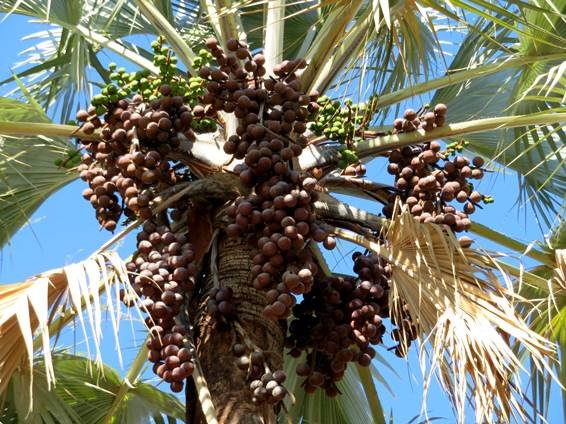Hyphaene petersiana, the mokola or makalani palm

Author: Ivan Lätti
Photographer: Susan Skog
Although this photo of Hyphaene petersiana was taken in Kaokoland in the north of Namibia where it is called the makalani palm, it is the same tree as the mokola palm or northern lala palm of the Limpopo and Mpumalanga Lowveld and, of course, the Kruger National Park. The other lala palm occurring in South Africa is H. coriacea, found both in the Lowveld and along the KwaZulu-Natal coast.
The latest crop of green fruit seen here, the smaller spheres up top in picture, may look like the ripe, purple-brown nuts below them, 5 cm in diameter, before any drop off. It takes these fruit up to two years to ripen and sometimes another two before they fall. Ripe fruit may be orange-red or pale to dark purple-brown. It has a thin, edible layer of spongy pulp, sweet tasting to ginger-flavoured around the hard kernel.
Remember this for the eventuality of a possible return to hunter-gatherer status in the northern regions of southern Africa after Covid-19. Should a knife be remembered for the backpack, the hard fruit kernel can be carved into small ornaments, known as vegetable ivory… a pleasurable enough pastime by the fireside while reminiscing about the good old days of DSTV and Netflix. Always good to master appropriate skills for emerging lifestyles!
Basket weaving from these fibrous palm leaves may also be remembered by some, containers so useful for food collection or other items when reverting to simpler lifestyles. The skills involved in weaving are a little trickier to master, as one should know things like the proper leaf age to pick and how much to break off for more harvesting from the same plants later. That is if one doesn’t want to walk too far for finding leaves and encountering aggressive competition from alien tribes or other long-toothed dangers in the unknown bush.
The boiling and drying of the leaves for weaving have to be done right. One could dye them, or some of them in different natural dye colours, obtained from the environment, if one knew where to look. Removal of the outer leaflet parts would be done by the smart weavers. This ensures pretty baskets suitable for trading, should money not be around.
An awl would be useful for the holes in the leaves. More importantly, the knowledge and dexterity for crafting the coils and spirals that appear like magic in the hands of proficient and master weavers.
Thinking about all this, did one ever pay enough for the handiwork of those roadside craftsmen and women when choosing a memento from the bush to take home?
And then the tree still offers palm wine, also obtained from some other palm trees, particularly H. coriacea.
But that is another story told elsewhere on this Site. Enter palm wine in the Search Box on this page to access it (Mannheimer and Curtis, (Ed.), 2009; Coates Palgrave, 2002; Van Wyk and Gericke, 2000; Van Wyk and Van Wyk, 1997).

